KISが国際バカロレア(IB)のPYP候補校になりました!
KISが国際バカロレア(IB)のPYP候補校になりました!
Kumamoto International School is a candidate school* for the PYP and is pursuing authorization as an IB World School. IB World Schools share a common philosophy – a commitment to high-quality, challenging, international education – that we believe is important for our students.
*Only schools authorized by the IB Organization can offer any of its four academic programmes: the Primary Years Programme (PYP), the Middle Years Programme (MYP), the Diploma Programme (DP), or the Career-related Programme (CP). Candidate status gives no guarantee that authorization will be granted. For further information about the IB and its programmes visit http://www.ibo.org.
As KIS works to become a fully accredited IB World School, we will work hard to further increase the quality of the education that we provide for all students.
熊本インターナショナルスクール小学部は国際バカロレア(IB)のPYP候補校*です。現在、IBワールドスクールの認定校になるための調整を進めています。IBワールドスクールは、チャレンジに満ちた優れた国際教育を提供するために尽力する、という共通の理念をもっています。
*国際バカロレア機構に認定を受けた学校のみが、IBの4つのプログラムである、初等教育プログラム(PYP:Primary Years Programme)、中等教育プログラム(MYP:Middle Years Programme)、ディプロマプログラム(DP)、キャリア関連プログラム(CP:Career-related Programme)を提供することができます。
現在はまだ候補校の段階ですので、これからも認定に向けて全職員が一丸となり教育体制の更なる向上に努めて参ります。
国際バカロレアについてより詳しくお知りになりたい方は以下リンクをご覧ください。
- 文部科学省IB教育推進コンソーシアム ウェブサイト
https://ibconsortium.mext.go.jp/ - 文部科学省IB教育推進コンソーシアム ウェブサイト(IBとは)https://ibconsortium.mext.go.jp/about-ib/
- 文部科学省「国際バカロレアについて」 ウェブサイト
http://www.mext.go.jp/a_menu/kokusai/ib
貯金箱 1年生 TDL
- /1年生
Our current TDL unit is the environment, pollution, and recycling. As part of our studies, we worked on a project that showed the students how to reuse, reduce, and recycle garbage in order to help keep our environment clean.
Instead of throwing out our school lunch milk containers, we washed them out carefully and made them into very cute, environmentally-friendly piggy banks! All grade 1 students had a lot of fun decorating their own piggy bank and thinking about what to do with all the coins they’re going to save!
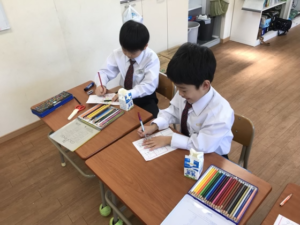
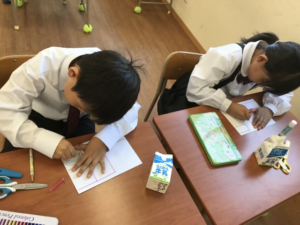
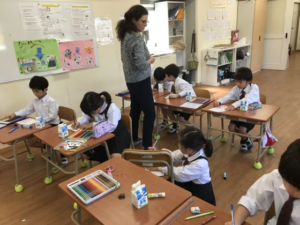
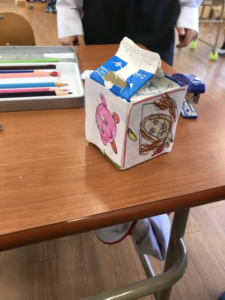
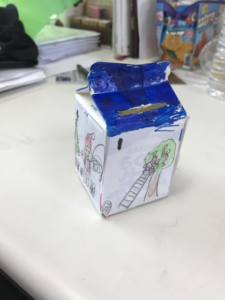
水の科学館遠足 - 1年生
- /1年生
Today we went on our second field trip, this time to the Water Science Museum. We rode the bus and the train to get to the museum, and once there, we broke into separate grade 1 and grade 2 groups. Grade 1 students learned about where the tap water in Kumamoto comes from. These activities tied in nicely to our TDL curriculum on pollution and natural resources, and the children could see first-hand what actually happens to dirty water and what the consequences of irresponsible water use are in our daily lives.
We were also able to enjoy a picnic outside (it didn’t rain, luckily!) and some delicious water that was gifted to us by the museum. All in all, a great day full of fun, learning, and new experiences!
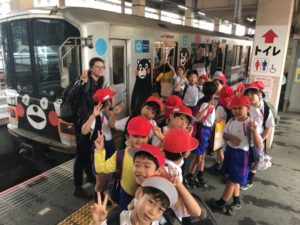
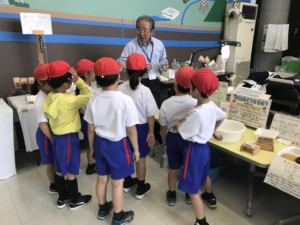
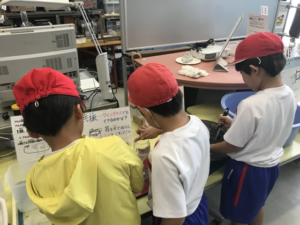




算数 - Math extension in the park - Grade 1
- /1年生
Since we are studying weight and the concept of “lighter”, “heavier”, “as heavy as…”, we spent some time in the park extending grade 1 math lessons to allow students to further apply what they are learning in the real world. After practicing in the classroom with a scale and various objects and units to measure weight, we decided to do a hands-on lesson and use the seesaw in the park in front of our school to review the concepts we learned all together!
The students took turns sitting on the seesaw to find out who is lighter or heavier, and we recorded the results. It was useful (not to mention very fun!) for the children to see how math is useful in real life, and how we can transfer what we learn in the classroom to actual first-hand experiences.

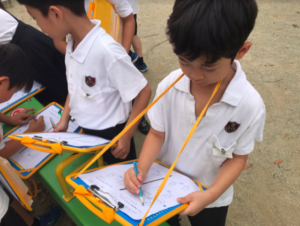
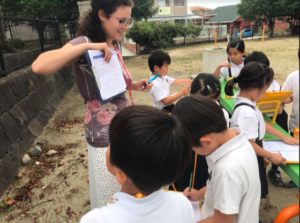
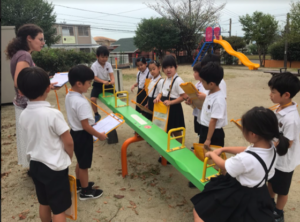
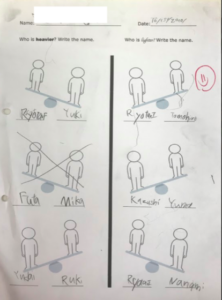
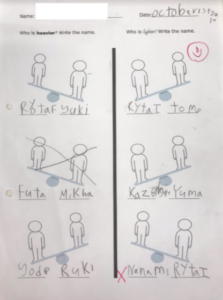
KIS 売店 の「Buyten」
In June, we began to offer the KIS Buyten store. Each day at the end of school, students are able to choose from a wide selection of fresh-made bread for consumption during snack time. All items are made fresh of natural ingredients with minimal preservatives by the the local bread shop, March.
March happens to be located almost adjacent to our Picasso preschool division, which means that many items are still warm when the students eat them. Melon bread, cheese bread, sausage bread, and the rice balls with chicken are current favorites among students (and staff).
All items cost ¥150 (including tax) and allow students to purchase nutritious, fresh snacks of their choosing. In addition to making life easier for our busy parents, we are excited to offer the Buyten because of the opportunity it provides to all students to learn about the value of money and making intelligent shopping decisions.

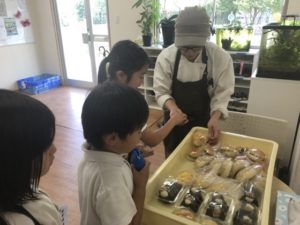
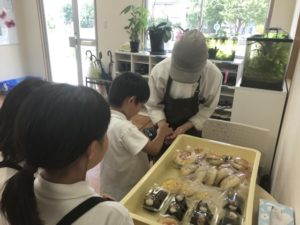
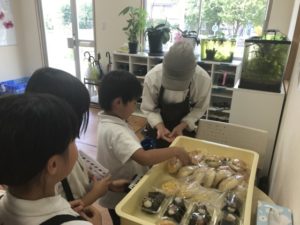
In June, we began to offer the KIS Buyten store. Each day at the end of school, students are able to choose from a wide selection of fresh-made bread for consumption during snack time. All items are made fresh of natural ingredients with minimal preservatives by the the local bread shop, March.
March happens to be located almost adjacent to our Picasso preschool division, which means that many items are still warm when the students eat them. Melon bread, cheese bread, sausage bread, and the rice balls with chicken are current favorites among students (and staff).
All items cost ¥150 (including tax) and allow students to purchase nutritious, fresh snacks of their choosing. In addition to making life easier for our busy parents, we are excited to offer the Buyten because of the opportunity it provides to all students to learn about the value of money and making intelligent shopping decisions.




ミルク牧場校外学習 - Aso Milk Farm field trip
On June 12th, both Grade 1 and Grade 2 classes went to the Aso Milk Farm for our first field trip of the year. It was a great day to go, with temperatures nice and cool for most of the morning. It was a long bus ride but the students were very patient.
Our first activity was inside in a classroom. Students were taught about how humans raise cattle. They were especially surprised to hear that cows would eventually become beef!
Next, the students were able to feed some of the cute cows stationed on the farm, and even see a large pregnant cow. She was massive indeed!
Our next stop was the sheep race where we all got to bet on which two animals would place first and second. We had a couple of winners in our group!
Before taking lunch, students had a Kokugo activity to complete that required them to pet animals. There were a lot to choose from including some sleepy dogs, skitty marmots, fluffy rabbits and a short-tempered pony!
So far, the day had been packed, with very little downtime. Lunch should have been a nice relaxing respite. However, it was interrupted by a bold, persistent crow.
After lunch and a little bit of play, the students got the chance to finally milk a cow. Student reactions were mixed: some were really fascinated and some thought it was a little gross. However, everyone agreed that it was worth doing!
Finally, we made ice cream and this was many students’ favorite activity by far!
All students listened and cooperated well during this session. Perhaps it was because failing to do so would mean that they wouldn’t get to eat ice cream?
The students were completely exhausted by the end of it all; some students slept on the bus ride home, but they really enjoyed the experience without a doubt!
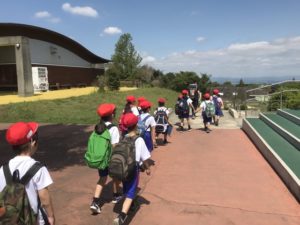
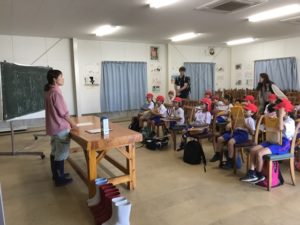
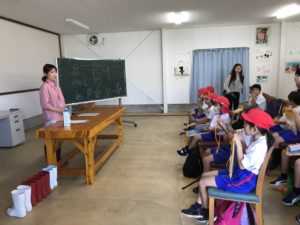
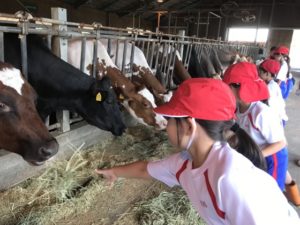
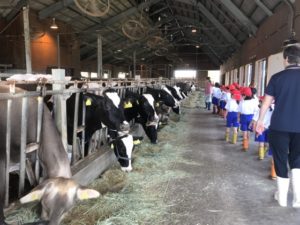
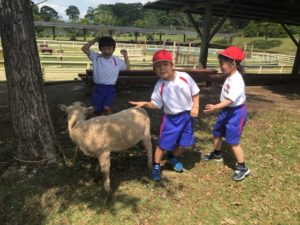
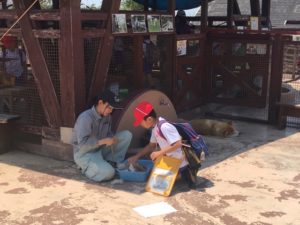
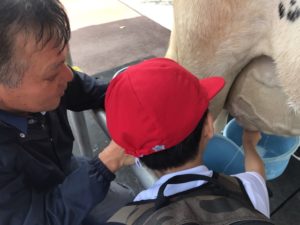
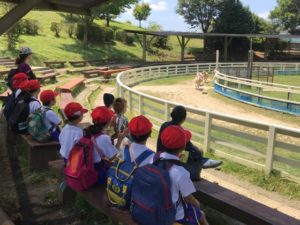

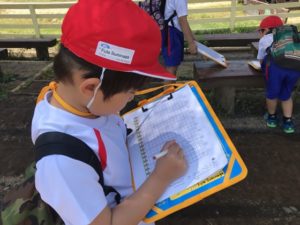
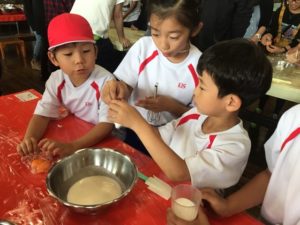
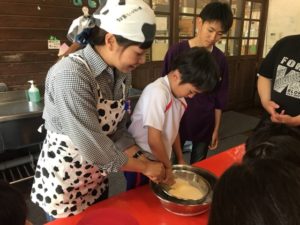
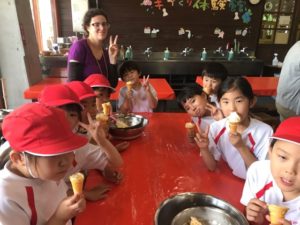
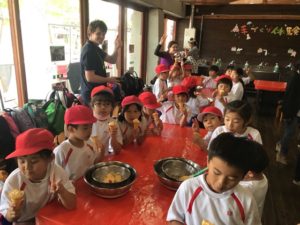

On June 12th, both Grade 1 and Grade 2 classes went to the Aso Milk Farm for our first field trip of the year. It was a great day to go, with temperatures nice and cool for most of the morning. It was a long bus ride but the students were very patient.
Our first activity was inside in a classroom. Students were taught about how humans raise cattle. They were especially surprised to hear that cows would eventually become beef!
Next, the students were able to feed some of the cute cows stationed on the farm, and even see a large pregnant cow. She was massive indeed!
Our next stop was the sheep race where we all got to bet on which two animals would place first and second. We had a couple of winners in our group!
Before taking lunch, students had a Kokugo activity to complete that required them to pet animals. There were a lot to choose from including some sleepy dogs, skitty marmots, fluffy rabbits and a short-tempered pony!
So far, the day had been packed, with very little downtime. Lunch should have been a nice relaxing respite. However, it was interrupted by a bold, persistent crow.
After lunch and a little bit of play, the students got the chance to finally milk a cow. Student reactions were mixed: some were really fascinated and some thought it was a little gross. However, everyone agreed that it was worth doing!
Finally, we made ice cream and this was many students’ favorite activity by far!
All students listened and cooperated well during this session. Perhaps it was because failing to do so would mean that they wouldn’t get to eat ice cream?
The students were completely exhausted by the end of it all; some students slept on the bus ride home, but they really enjoyed the experience without a doubt.
















Grade 1 math - number bonds and word problems(算数)
- /1年生
In math, Grade 1 students have mastered the concept of comparing numbers and being able to tell which of two numbers is bigger or smaller. With practice, they have become faster and more proficient with number bonds, and we were able to tackle the first major math milestone: addition of numbers up to ten, and how to use it to solve word problems.
Currently, we are working on developing speed in addition and understanding that the order of the numbers in a math problem doesn’t change the result. For this unit, we are gradually moving away from using physical manipulatives to solve problems in order to foster abstract thinking skills in the students and focus more on solving real-world problems.
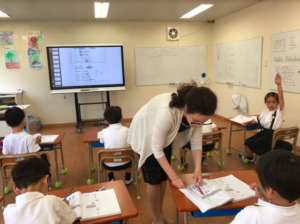
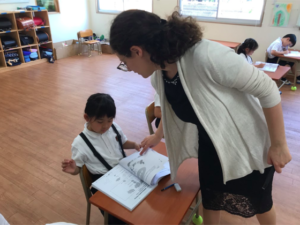

In math, Grade 1 students have mastered the concept of comparing numbers and being able to tell which of two numbers is bigger or smaller. With practice, they have become faster and more proficient with number bonds, and we were able to tackle the first major math milestone: addition of numbers up to ten, and how to use it to solve word problems.
Currently, we are working on developing speed in addition and understanding that the order of the numbers in a math problem doesn’t change the result. For this unit, we are gradually moving away from using physical manipulatives to solve problems in order to foster abstract thinking skills in the students and focus more on solving real-world problems.



Grade 1 Math (算数)
- /1年生
In Grade 1 math, we are currently studying numbers 1 – 10 and the concepts of “more” and “less”. In Singapore math, all concepts are studied using 1) manipulatives, 2) pictorial images / models, and 3) as abstract concepts. This three step process helps students to grasp even difficult mathematical concepts and makes math fun and accessible for all students. Lessons are a mix of electronic whiteboard work, manipulatives, and workbook practice. Grade 1 students are doing a great job of understanding these fundamental mathematical concepts.

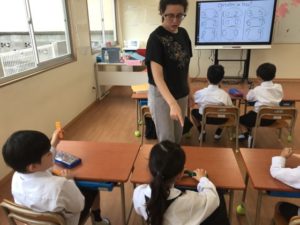
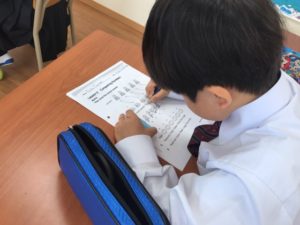
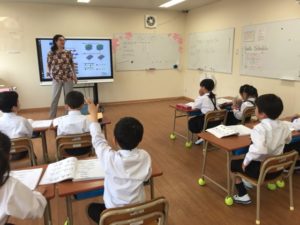
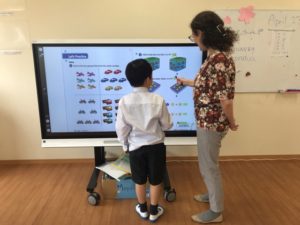
In Grade 1 math, we are currently studying numbers 1 – 10 and the concepts of “more” and “less”. In Singapore math, all concepts are studied using 1) manipulatives, 2) pictorial images / models, and 3) as abstract concepts. This three step process helps students to grasp even difficult mathematical concepts and makes math fun and accessible for all students. Lessons are a mix of electronic whiteboard work, manipulatives, and workbook practice. Grade 1 students are doing a great job of understanding these fundamental mathematical concepts.





Fire Drill (避難訓練)
On May 15th, we did our May fire drill. After discussing the importance of following teacher directions and leaving the building quickly and quietly without trying to get any of our things, we had a perfect fire drill. Covered their faces with their hand towels as they left the building, all students followed all teacher directions perfectly. In all, everyone was evacuated in under two minutes.
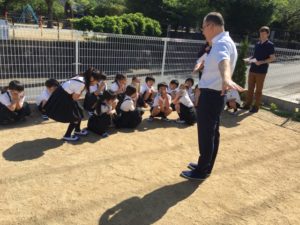
On May 15th, we did our May fire drill. After discussing the importance of following teacher directions and leaving the building quickly and quietly without trying to get any of our things, we had a perfect fire drill. Covered their faces with their hand towels as they left the building, all students followed all teacher directions perfectly. In all, everyone was evacuated in under two minutes.

Grade 1 Lunch (給食)
- /1年生
Grade 1 students are getting used to all aspects of the KIS daily schedule, including being good class helpers. Students can eat as much hot rice and hot soup as they want each day, and students often come back for seconds. Grade 1 students are also getting better at focusing on eating so that they can get a longer recess after eating and cleaning the classroom.
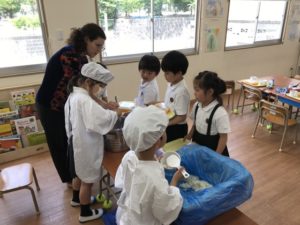
Grade 1 students are getting used to all aspects of the KIS daily schedule, including being good class helpers. Students can eat as much hot rice and hot soup as they want each day, and students often come back for seconds. Grade 1 students are also getting better at focusing on eating so that they can get a longer recess after eating and cleaning the classroom.


